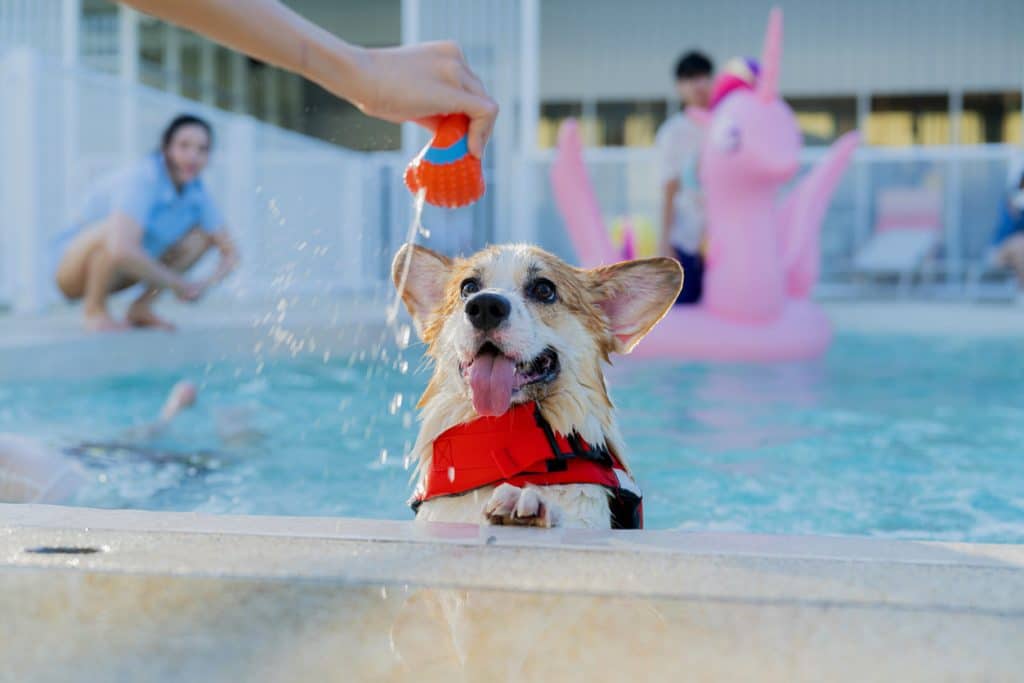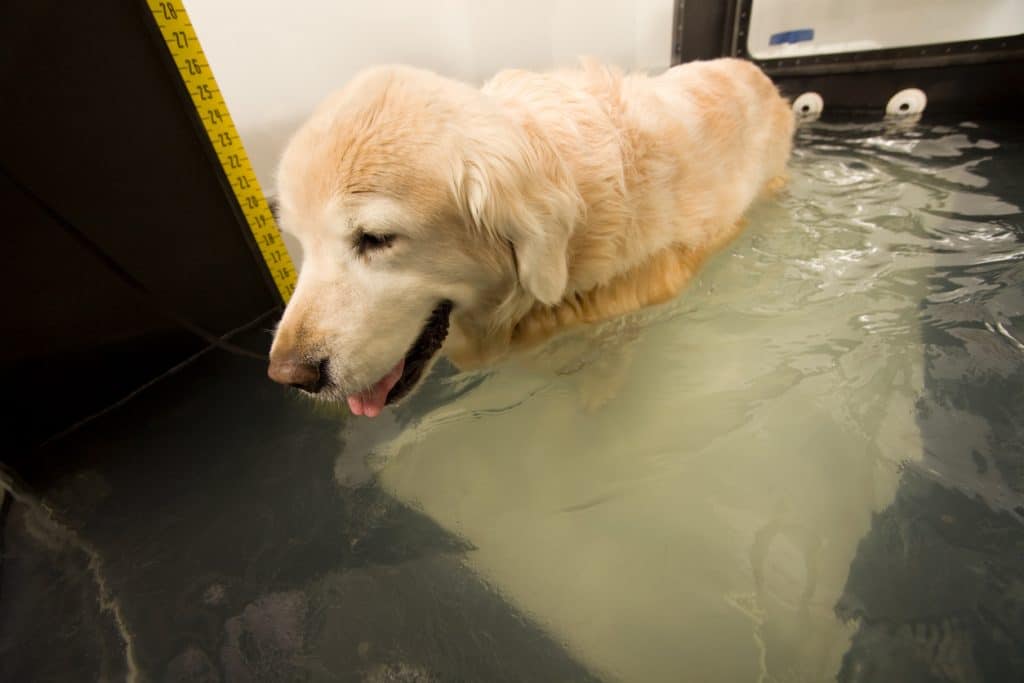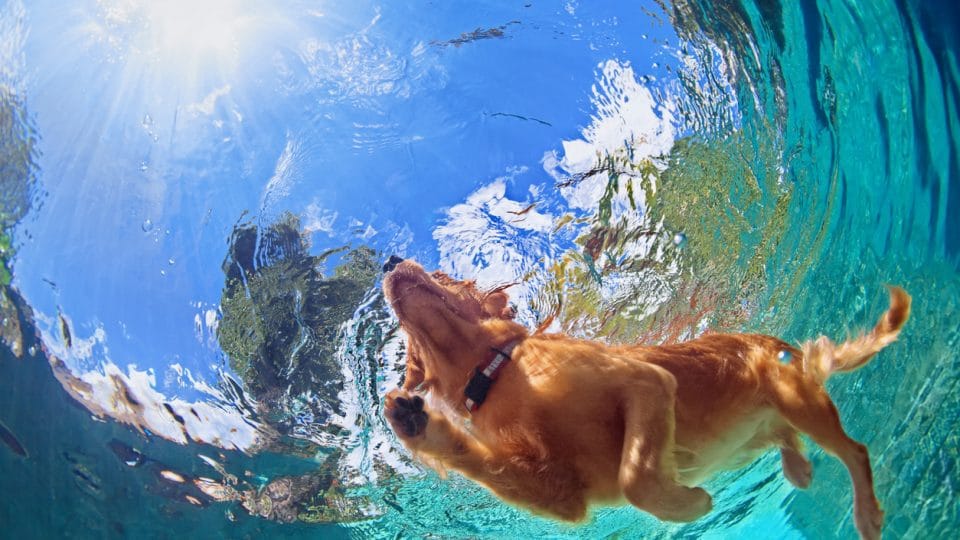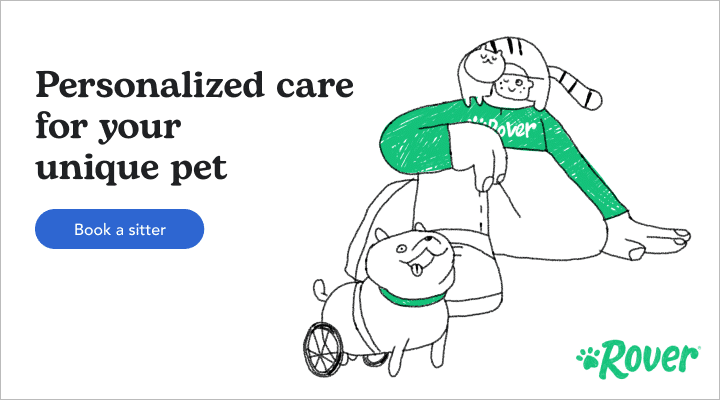- Not a substitute for professional veterinary help.
In addition to being good exercise for your dog, being in the water may also benefit to their physical health. Enter hydrotherapy.
Hydrotherapy for dogs includes therapeutic exercises performed in water to aid with mobility, strength, and recovery. The buoyancy of water can help dogs with joint-issues move with less pain and concern.
We’ll explore, with the help of Dr. Gary Richter, veterinarian and founder of Ultimate Pet Nutrition, how hydrotherapy may be an exercise to pursue with your dog. Keep in mind as beneficial as hydrotherapy is never leave a dog to swim unsupervised in the water.
Benefits of Hydrotherapy
1. Good for joints
“Hydrotherapy allows dogs to exercise in a way that’s not going to hurt their joints,” says Dr. Richter. “It gives them buoyancy, so [your dog is] not putting a lot of pressure through their joints and causing more issues.”
2. Good for heart and circulatory health
“Swimming is good for their cardiovascular health,” says Dr. Richter.
The good aerobic exercise is very low impact on the joints, helping dogs avoid joint pain or damage over time. Just like with people, the “weightlessness” type feeling we have in water allows people, dogs, and other animals to move in different ways that are much easier than on land.
3. Good for arthritis or injury recovery
Hydrotherapy can help ease pain in senior dogs, dogs with arthritis, dogs recovering from injuries, and even help train athlete dogs.
A small clinical study of 13 dogs found that swimming helped with range of motion for dogs, more than walking on land alone. Hydrotherapy can be a great step for when you need to exercise your dog more but don’t want them to overwork themselves on walks.
“Hydrotherapy really helps with range of motion, meaning getting those joints to move through the range that they’re supposed to move in,” says Dr. Richter.

iStock/travelism
4. Good for weight management
“Sometimes dogs don’t exercise because they’re so heavy, they can’t. [But] when you put them in water, they’re buoyant, so they’re not having to bear their full weight anymore,” says Dr. Richter. “So all of a sudden, they can do stuff that they couldn’t do on land.”
Buoyancy makes bearing weight easier, but hydrotherapy is still be a substantial work out. “We’ve all had the experience of, either at the beach or in a swimming pool, walking in, in water,” says Dr. Richter. “There’s a lot of resistance involved, much more so than there would be walking through air.”
5. Prevent future injuries
Hydrotherapy can also be preventative and may be a good option for athlete dogs. After all, the better shape an athletic dog is in, the less likely they are to sustain an injury.
“It’s also a way to condition a dog where they’re very unlikely to get injured during that therapy, because it’s so low impact. It just helps them be in better shape. So that way when they’re off doing whatever their particular activity is less likely to get hurt,” says Dr. Richter.
6. Alleviate symptoms in other conditions
The other demographic that may also find hydrotherapy beneficial? Dogs with neurological issues.
Dr. Richter explains that though neurological dysfunction can stem from a number of issues, it usually is comprised of a combination of pain and weakness. Using an underwater treadmill (more on that in a minute) may help a dog with these issues walk with less pain and the buoyancy helps them stand up more easily.
The underwater treadmill hydrotherapy in particular can be a great option for dogs who aren’t walking normally due to their neurological issue, as they often need gait retraining.
“[Gait retraining] basically means we have to teach them how to walk properly,” says Dr. Richter. “Because of the buoyancy and resistance, it’s a much, much easier thing to do in the water, because it almost becomes walking in slow motion in a way that you couldn’t be on land.”
Types of Hydrotherapy
Here are the potential benefits of each type of dog hydrotherapy:
- Underwater treadmill: Good for cardiovascular health, muscle building, improving range of motion, perform exercise with less pain, and gait retraining.
- Swimming pool: Good for cardiovascular health, muscle building, circulatory health, aerobic exercise, fun for dog, and low impact exercise. Dr. Richter notes that dogs primarily swim using the front part of the body, so it may not always help with issues in a dog’s rear end, which move less during swimming.
- Whirlpool: Good for circulation and loosening muscles and joints. “Because of the warmth of the water,” says Dr. Richter, “it’s bringing blood to the outer surfaces of the body.” This helps promote circulation to the joints and loosens things up to feel better.

iStock/BanksPhotos
Is Hydrotherapy for Dogs Safe?
Putting your dog in the water can sound a little dangerous, but in a professional setting, there may be some extra eyes to help you supervise your dog as they swim.
Dr. Richter says a vet tech is always in the water with the dog at his facility. “There’s always a hand on the dog. While they’re swimming—except for really, really strong swimmers—they’re all wearing a flotation device.” When researching hydrotherapy clinics, make sure they verify who will be with your dog and what kind of assistance they can provide.
How Often Should a Dog Do Hydrotherapy?
How long and how often your dog can do hydrotherapy depends on the dog and the reasons why they are there. Dr. Richter typically doesn’t recommend beyond twice a week to avoid tiredness and soreness.
“The thing about any kind of therapy with dogs, whether it’s hydrotherapy, or anything else is, it requires the cooperation of the dog,” says Dr. Richter. “If I injure myself, and I wind up going to a physical therapist, they’re going to tell me to push through the pain because it’s good for me, and I’ll do it. You can’t make a dog do that. If you can’t make it fun, the dog is not going to participate. As such, we wind up using a lot of peanut butter!”
Can You Do Hydrotherapy At Home?
It’s one thing if you have a swimming pool at home where you can get in the pool with your dog in a floatation device, but otherwise, according to Dr. Richter, it’s difficult to achieve the benefits of hydrotherapy with say a kiddie pool, dog swimming pool, or bathtub, unless the dog is very small.
Does Your Dog Need Hydrotherapy?
Like swimming, hydrotherapy is good exercise for your dog. But it may not be right for your dog or for you, if your dogs hates the water or your have a strict budget. That said, hydrotherapy is an excellent option for dogs:
- Needing rehabilitation from an injury or surgery
- With health issues, such as arthritis to neurological dysfunction
- Who are athletes and need to exercise with less pressure on their joints
- Are in a weight management program and need help with movement
If hydrotherapy is the right fit for you and your dog, check out the Association of Canine Water Therapy to find a location near you. If hydrotherapy isn’t an option, you can try physical therapy exercises at home. Shortening your walk to multiple ones throughout the dog rather than one long one can help.
“Generally speaking, if the dog has mobility problems, a really long walk might cause them to get tired or be painful,” says Dr. Richter. “Three, four walks over the course of the day, just not for that long so they’re not getting tired, can be a good way to do it.”
You can also try reach out to canine rehabilitation trainers. “Just like with exercise with people, if you do the wrong exercise for your body, you can get hurt,” says Dr. Richter. “Obviously, nobody wants to do that with the dog. So you really need a little bit of guidance from a professional.”





